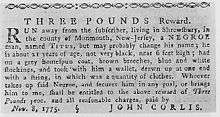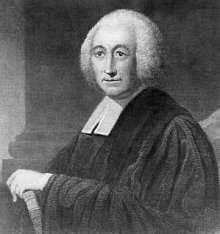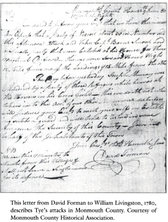Colonel Tye
Titus Cornelius, also known as Titus, Tye, and famously as Colonel Tye (c. 1753 – 1780), was a slave of African descent in the Province of New Jersey who fought as a Black Loyalist during the American Revolutionary War; he was known for his leadership and fighting skills. He fought with a volunteer corps of escaped Virginia Colony slaves in the Ethiopian Regiment and the "Black Brigade" associators. Tye died from tetanus and lockjaw from a musket wound in the wrist following a short siege in September 1780 against Captain Joshua Huddy. Tye was one of the most feared and effective guerrilla leaders opposing the American patriot forces in central New Jersey.[1][2]
Colonel Tye | |
|---|---|
| Born | Titus Cornelius c. 1753 Colt's Neck, Monmouth County, Province of New Jersey, present-day Colts Neck Township, Monmouth County, New Jersey |
| Died | 1780 (aged c. 27) Monmouth County, Province of New Jersey, present-day Monmouth County, New Jersey |
| Cause of death | tetanus and lockjaw from gunshot wound |
| Other names | Tye |
| Occupation | slave, soldier, colonial militia officer |
| Title | Colonel |
| Military career | |
| Allegiance | |
| Service/ | Ethiopian Regiment (1775-1776) Black Brigade (1778-1780) |
| Years of service | 1775–1780 |
| Rank | Colonel (honorary rank) |
| Commands held | Black Brigade |
| Battles/wars | American Revolutionary War
|
Early life and slavery
Titus Cornelius was born into slavery in Colt's Neck, Monmouth County, Province of New Jersey and originally owned by John Corlies, a Quaker. Corlies's farm was located along the Navesink River, near the town of Shrewsbury, and Titus worked there in his early life.[3] At the onset of the American Revolution, there were about 8,200 slaves in the Province of New Jersey, second only to the Province of New York among the northern American colonies, in both the number and percentage of African-Americans.[4] Corlies, Titus's owner, held slaves despite his denomination's increasing opposition to slavery.
By the 1760s, it was Quaker practice to teach slaves how to read and write and to free them at age 21. Yet, Corlies gave his slaves "no learning [and was] not inclined to give them any".[4] Known to be hard on his slaves, Corlies severely whipped them for minor causes.[1] Corlies also kept his slaves past the age of 21, and he was one of the last slaveholders in the region.[2] In late 1775, a delegation from the Shrewsbury Meeting of the Society of Friends approached Corlies about his treatment of his slaves. The group of Quakers disapproved of Corlies's refusal to provide his slaves an education and his lack of adherence to the 1758 Quaker edict to end slavery. Corlies responded by saying that "he has not seen it his duty to give [the slaves] their freedom".[5] Titus learned on his own about property, wealth, commodities, and the political leanings of the families in the area.[3] Later, in 1778, the Society of Friends revoked Corlies's membership because of his unyielding refusal to emancipate his slaves.[5]
Prelude to Revolution
_(14797841343).jpg)
In November 1775, John Murray, 4th Earl of Dunmore, the royal governor of Virginia, issued a proclamation offering freedom to all slaves and indentured servants who would leave American masters and join the British. Lord Dunmore's act successfully prompted conspiracy among slaves in the Atlantic region, as many African Americans left their rebel masters to join the British.[5] The proclamation and the disruption of the war contributed to an estimated nearly 100,000 slaves escaping during the Revolution, some to join the British. Planters considered Dunmore's offer a "diabolical scheme"; it contributed to their support for the Patriot cause.

Titus Cornelius coincidentally escaped from Corlies's property the day after Dunmore's proclamation and he joined British forces. Titus observed the Quakers' unsuccessful attempts to persuade Corlies to free his slaves. Reaching his twenty-first birthday also inspired Titus to escape, as it marked the age when most Quakers freed their slaves.[5] Carrying only a small amount of clothing "drawn up at one end with string", Titus left Corlies's property and walked toward Williamsburg, Virginia.[4] Corlies placed advertisements in Pennsylvania newspapers, promising a reward of "three pounds of proclamation money" for capturing Titus.[4]
American Revolutionary War

Ethiopian Regiment service
Assuming the adopted name of "Tye", Titus enlisted in the Ethiopian Regiment. In his first experience seeing action at the Battle of Monmouth in June 1778, Tye captured Captain Elisha Shepard of the Monmouth militia and brought him to his imprisonment at the Sugar House in British-occupied New York City.[4][5] Fought near Freehold, New Jersey, the Battle of Monmouth proved to be indecisive militarily, but it introduced British and Patriot forces to Tye's great ability as a soldier.[5]
Leadership of Black Brigade
Colonel Tye's knowledge of the topography of Monmouth County and his bold leadership soon made him a well-known and feared Loyalist guerrilla commander. The British paid him and his group, consisting of blacks and whites, to destabilize the region. Orchestrated by Royal Governor William Franklin, the Loyalist son of Benjamin Franklin, this plan was an act of retaliation, in response to the Patriot confiscation of Tory properties.[5] When Monmouth Patriots began to hang captured Tories under the vigilante law that governed Monmouth County, Franklin and other British officials raided Patriot towns.[5] On July 15, 1779, accompanied by a Tory named, John Moody and 50 African Americans, Tye executed a daring raid on Shrewsbury, New Jersey, during which they captured 80 cattle, 20 horses, and William Brindley and Elisha Cook, two well-known inhabitants.[2][4][5] British officers paid Tye and his men five gold guineas for their successful raids.[5] Tye and his fellow guerrilla fighters operated out of a forested base called Refugeetown in Sandy Hook.[4] They often targeted wealthy, slaveholding Patriots during their assaults, which frequently took place at night.[4] Tye led several successful raids during the summer of 1779, seizing food and fuel, taking prisoners, and freeing many slaves.
By the winter of 1779, Colonel Tye served with the "Black Brigade", a group of 24 black Loyalists. Tye's group worked in tandem with a white Loyalist unit, known as the "Queen's Rangers", to defend British-occupied New York City. Traveling undetected into the towns of Monmouth County, Tye and his men seized cattle, forage, and silverplate, and returned the resources to the weakened British forces.[6] The Black Brigade also helped to usher escaping slaves to their freedom inside British lines, and later assisted their transportation to Nova Scotia for resettlement.[7] They also raided patriot sympathizers in New Jersey, captured them, and brought them to the British in return for rewards.[2] Due to their unjust treatment as slaves, the Black Brigade often aimed their raids at former masters and their friends.[5] Because the members of the Black Brigade knew the homes of Patriots from their time as slaves, the Patriots feared the Black Brigade more than the regular British army.[7]


Henry Muhlenberg, a German Lutheran pastor sent to the colonies as a missionary, commented on how formidable the Black Brigade was: "The worst is to be feared from the irregular troops whom the so-called Tories have assembled from various nationalities– for example, a regiment of Catholics, a regiment of Negroes, who are fitted for and inclined towards barbarities, are lack in human feeling and are familiar with every corner of the country."[7] Reports that African Americans planned massacres of whites in Elizabeth and in Somerset County inflamed the local population's fear of Tye and his men.[5] Led by David Forman, the brigadier general of the New Jersey militia, the Monmouth County Whigs organized the Association for Retaliation to protect themselves against Tye and other Loyalist raids.[3] Panicked white Patriots pleaded with Governor William Livingston to send assistance.[4] For example, David Forman wrote to Livingston detailing the extent of Tye's attacks. Livingston responded by invoking martial law. This was a catalyst that convinced more African Americans to flee to British-held New York.[2] For example, 29 male and female African Americans left slave owners in Bergen County during this time.[6] In response, Livingston and his officials encouraged slaveholders to remove their slaves to more remote parts of New Jersey.[6]
On March 30, 1780, the Black Brigade captured Captain James Green and Ensign John Morris.[5] In the same raid, Tye and his men looted and burned the home of John Russell, a Patriot known for his raids on Staten Island.[5] Shortly thereafter, Tye and his men killed Russell and wounded his young son.[5]
Beginning in June 1780, Tye led more attacks in Monmouth County. His forces attacked and killed Joseph Murray in his home in retaliation for Murray's vigilante executions of loyalists.[4] He also raided Barnes Smock, a leader of Patriot militia in Monmouth County. Tye captured 12 of Smock's supporters and destroyed his artillery.[2] In one noteworthy raid on June 22, 1780, Tye and his men captured James Mott, the second major in the Monmouth's militia regiment; James Johnson, a captain in the Hunterdon militia, and 6 other militia men.[5] On September 1, 1780, Tye led a small group of African Americans and Queen's Rangers to Colt's Neck, New Jersey, with the aim of raiding the home of Captain Joshua Huddy. Known for his swift execution of captured Loyalists, Huddy was an important target for Tye and his band. Tye briefly captured Huddy, but in a surprise attack, a party of Patriots helped Huddy escape.[4] Huddy and a female servant had managed to resist Tye's band for two hours before the Loyalists set fire to the house.[2] The Patriots injured Tye in the fight, firing a musket ball through his wrist.
Death
Colonel Tye developed tetanus and gangrene from the wound suffered in the raid against Huddy. Tye died two days later from the infection.[1][2]
Colonel Blucke, the new leader of Black Brigade
Colonel Stephen Blucke, who commanded the Black Loyalist unit, the Black Company of Pioneers, led Tye's troops following his death. Blucke successfully led the group for the rest of the war, even operating after the British surrender at Yorktown.[2] On March 24, 1782, a group of avenging Tories captured the rebel Huddy and interned him aboard a British prison ship. On April 12, 1782, the Tories hanged Huddy on a beach at the foot of the Navesink Highlands.
Legacy
Often considered one of the most effective and respected African-American soldiers of the Revolution, Tye made significant contributions to the British cause.[8] Although never commissioned an officer by the British Army, Colonel Tye earned his honorary title as a sign of respect for his tactical and leadership skills. The British often granted such titles to other noteworthy black officers in Jamaica and other West Indian islands.[5] The British army did not formally appoint anyone of African descent to such positions; however, the Royal Navy did commission black officers. Tye's knowledge of the swamps, rivers, and inlets in Monmouth County was integral to the British efforts in New Jersey during the war. As the commander of the Black Brigade, he led raids against American patriots, seized supplies, and assassinated Patriot leaders during the war.
Colonel Tye served as an example of the role of African Americans during the Revolutionary War. Lord Dunmore's proclamation involved the African-American population in the war in a manner not yet seen. The promise of freedom inspired African-American men like Tye to join the Loyalist cause. Tye and his men captured important Patriot militiamen, launched numerous raids, and seized scarce resources from the local population. Their actions gained the attention of Governor William Livingston, who invoked martial law in New Jersey as a result in an attempt to restore order. The actions of Tye and other former slaves provoked whites' fear that wartime abolition would cause further dislocation and disorder in the region.[9] Further, Tye's exploits intensified white anxieties about slave revolt and served to reinforce anti-abolition sentiment.[9]
Representation in popular culture
- Colonel Tye and other Black Loyalists are among the subjects of PBS' Slavery and the Making of America.
- Colonial Williamsburg actor-interpreters portray the Royal Ethiopian Regiment of Virginia in their reenactments.[10]
See also
Further reading
- Egerton, Douglas R., Death of Liberty: African Americans and Revolutionary America, Oxford University Press, 2009.
- Gigantino, James J., The American Revolution in New Jersey: Where the Battlefront Meets the Home Front, Rutgers University Press, 2015.
- Gigantino, James J. The Ragged Road to Abolition: Slavery and Freedom in New Jersey, 1775-1865 Philadelphia, PA: University of Pennsylvania Press, 2014.
- Hodges, Graham Russell, Slavery, and Freedom in the Rural North: African Americans in Monmouth County, New Jersey, 1665–1865, Rowman & Littlefield, 1997.
- Hodges, Graham Russell, Root and Branch: African Americans and Revolutionary America, Oxford University, 2005.
- Hodges, Graham Russell, Slavery Freedom and Culture Among Early American Workers, M.E. Sharpe, 1998.
- Papas, Philip, That Ever Loyal Island: Staten Island and the American Revolution, NYU Press, 2009.
- Sutherland, Jonathan, African Americans at War: An Encyclopedia, Volume 1, ABC-CLIO, 2003.
- Wilson, Ellen Gibson, Loyal Blacks, New York: G.P. Putnam's Sons, 1976.
References
- "Colonel Tye", Africans in America, PBS
- Sutherland, Jonathan. (12 January 2003). African Americans at War: An Encyclopedia.
- Papas, Phillip. (1 March 2009). That Ever Loyal Island: Staten Island and the American Revolution. NYU Press.
- Egerton, Douglas R. (13 January 2009). Death or Liberty: African Americans and Revolutionary America. Oxford University Press.
- Hodges, Graham Russell. (1 January 1997). Slavery and Freedom in the Rural North: African Americans in Monmouth County, New Jersey, 1665-1865. Rowman & Littlefield.
- Hodges, Graham Russell. (12 October 2005). Root and Branch: African Americans in New York and East Jersey, 1613-1863. University of North Carolina Press.
- Hodges, Graham Russell. (1 January 1998). Slavery, Freedom and Culture Among Early American Workers. M.E. Sharpe.
- "CDC: Black Loyalists". blackloyalist.com. Retrieved 29 April 2016.
- Gigantino, James J. (1 April 2015). The American Revolution in New Jersey: Where the Battlefront Meets the Home Front. Rutgers University Press.
- "American Revolution | Slavery and Remembrance". slaveryandremembrance.org. Retrieved 29 April 2016.
External links
- "Colonel Tye". Black Loyalists: Our History, Our People. Canada's Digital Collections. Retrieved 25 February 2012.
- "The Black Pioneers". Black Loyalists: Our History, Our People. Canada's Digital Collections. Retrieved 25 February 2012.
- "The Royal Ethiopian Regiment". Black Loyalists: Our History, Our People. Canada's Digital Collections. Retrieved 25 February 2012.
- "Colonel Tye", StudyThePast.com
- "Colonel Tye", Children's play, Liberty's Kids
- "Ethiopian Regiment", The On-Line Institute for Advanced Loyalist Studies
- "A History of the Black Pioneers". The On-Line Institute for Advanced Loyalist Studies. Retrieved 25 February 2012.
